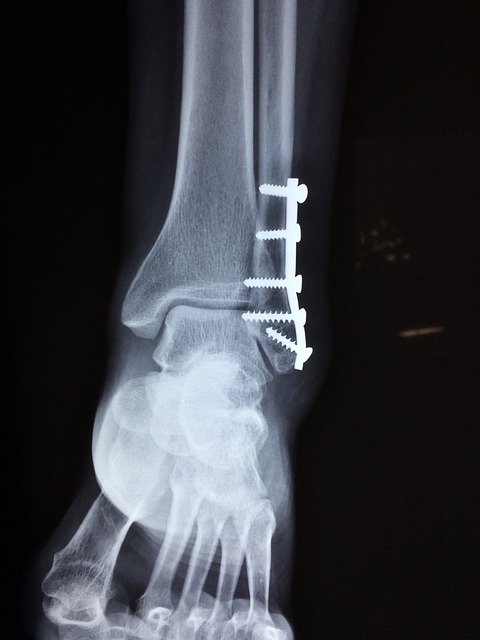Technical Terms of Corrosion Simplified
- Stress corrosion cracking
- Pitting
- Intergranular corrosionIntergranular corrosion
- Corrosion fatigue
- Crevice corrosion
- Passivation
- Galvanic corrosion
Stress Corrosion Cracking
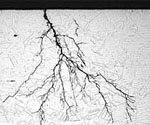
Stress corrosion cracking or SCC occurs when these two factors occur simultaneously:
1. Tensile stress (either directly applied or residual stress)
2. Corrosive environment like saltwater or acid
The tricky part about stress corrosion cracking is that it may occur in mildly acidic environments which typically cause little or no effect to the material. It is only the combination of stress and corrosive media which causes it to occur – both factors must be present for SCC to take place. As most of the surface remains unattacked, except for a few fine cracks, the material may appear unharmed – metals often remain bright and shiny – causing SCC to go undetected until unexpected failures occur.
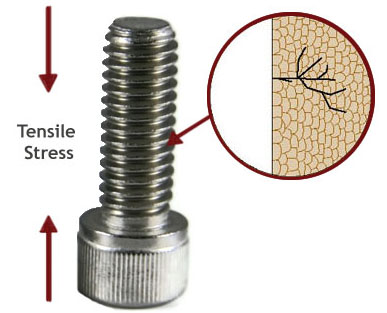 Materials In Focus:
Materials In Focus:
SCC of nickel alloys has been found to occur in three types of environments: high-temperature halogen-ionic solutions, high-temperature waters, and high-temperature alkaline environments.
- C276 offers excellent stress corrosion cracking resistance many acidic, reducing and mildly oxidizing environments.
- Monel fasteners and flanges prevent stress corrosion cracking and pitting in most fresh and industrial waters; whereas stagnant salt water situations can sometimes result in crevice and pitting corrosion to occur.
- AL-6XN’s high nickel and molybdenum contents make it resistant to SCC (stress corrosion cracking) in chloride.
Pitting
 This is an extremely localized corrosion that leads to the creation of small holes in the material. Once pitting corrosion occurs, it can quickly spread into the material, corroding it entirely. An easy way to wrap your brain around this concept is a tooth with a cavity – where there is a small point of decay that can spread throughout your tooth. Pitting is often the most destructive form of corrosion and the most difficult to detect since the pits that cause the initial attack are often very small yet corrode deeply.
This is an extremely localized corrosion that leads to the creation of small holes in the material. Once pitting corrosion occurs, it can quickly spread into the material, corroding it entirely. An easy way to wrap your brain around this concept is a tooth with a cavity – where there is a small point of decay that can spread throughout your tooth. Pitting is often the most destructive form of corrosion and the most difficult to detect since the pits that cause the initial attack are often very small yet corrode deeply. 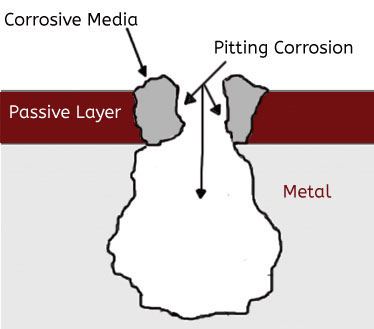
Pitting corrosion typically occurs when there are points of weakness in the passive layer. Pitting is affected most by acids, chlorides and high temperature. Chloride is particularly damaging to the protective passive layer of a metal so pitting can initiate at oxide breaks.
Materials In Focus:
- AL-6XN is an ideal choice to help prevent pitting corrosion in chloride environments.
- Titanium has been shown to have no signs of pitting corrosion even after years of submersion in seawater.
Intergranular Corrosion
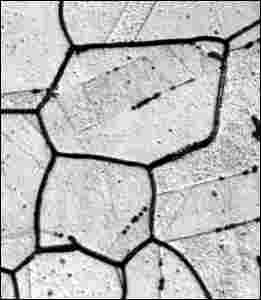 This is where the grain boundaries of the material’s structure are more susceptible to corrosion. So what does that mean? Each material is made up of grains, surrounded by grain boundaries, packed tightly together to form the metal or alloy.
This is where the grain boundaries of the material’s structure are more susceptible to corrosion. So what does that mean? Each material is made up of grains, surrounded by grain boundaries, packed tightly together to form the metal or alloy.
Think of the material like a brick wall, with the grains of the material being the bricks and the grain boundaries being the mortar. Intergranular corrosion occurs in the mortar (grain 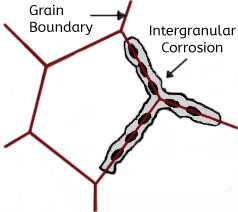 boundaries) or along the edge of the mortar while the grains themselves (or for our example the bricks) remain largely unaffected.
boundaries) or along the edge of the mortar while the grains themselves (or for our example the bricks) remain largely unaffected.
Intergranular corrosion is a localized attack affecting the grain boundaries rather than the grains. Even though corrosion only occurs at the grain boundaries, it will still cause the material to disintegrate. Think of our brick wall. If you destroy the mortar the wall will fall, even if the bricks themselves are still intact.
Intergranular corrosion is typically caused by:
- Impurities at the grain boundaries
- Enrichment of one of the alloying elements
- Depletion of an alloy element in the grain-boundary area
Corrosion Fatigue
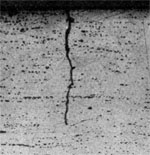 This type of corrosion occurs when there are cycles of stress on a material in a corrosive environment. The altering stresses are thought to cause the passive protective film to break which causes the underlying material to occur. Keep in mind that often the rapidly fluctuating stresses may be well below the tensile strength of the material. Similar to stress corrosion cracking, corrosion fatigue is caused by cyclic stresses whereas SCC is brought on by constant stress.
This type of corrosion occurs when there are cycles of stress on a material in a corrosive environment. The altering stresses are thought to cause the passive protective film to break which causes the underlying material to occur. Keep in mind that often the rapidly fluctuating stresses may be well below the tensile strength of the material. Similar to stress corrosion cracking, corrosion fatigue is caused by cyclic stresses whereas SCC is brought on by constant stress.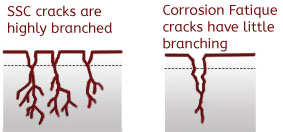
Think of it like a shoe. Cycling stress occurs when you are walking (verses the constant stress of standing – SCC). This altering stress can cause cracks or breaks in this protective soles (like the passive layer).
Crevice Corrosion
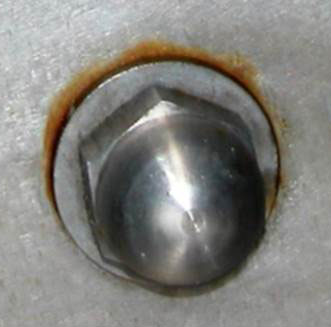 Crevice corrosion is an intense localized corrosion, which occurs within crevices or gaps between two joining services. It can occur in the crevice or gap between two metals or a metal and non-metallic material. Outside this area the materials may be completely resistant to the
Crevice corrosion is an intense localized corrosion, which occurs within crevices or gaps between two joining services. It can occur in the crevice or gap between two metals or a metal and non-metallic material. Outside this area the materials may be completely resistant to the 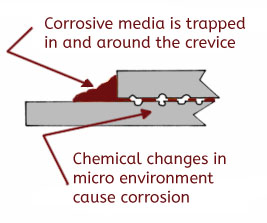 corrosive environment, but when the corrosive solution becomes trapped or stagnant in this gap, chemical changes can occur in the solution causing the micro environment to be very corrosive.
corrosive environment, but when the corrosive solution becomes trapped or stagnant in this gap, chemical changes can occur in the solution causing the micro environment to be very corrosive.
Passivation
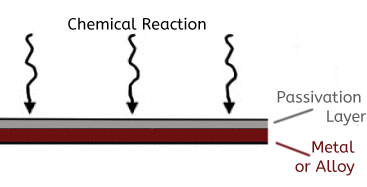
This is the creation of an outer protective layer to a material – also called the passive layer. It is formed when a chemical reaction occurs with the base material to rapidly oxidize the surface. In terms of many metals and alloys, this technique creates a metal oxide layer that protects the base material from corrosion and is especially important on materials that form this oxide layer slowly, like steel but much less important for corrosion resistant alloys like Hastelloy C276 as the oxide layer is readily formed in air. It is called a “passive” layer as it is less affected by the environment. A simple example is the tarnish of silver.
Galvanic Corrosion
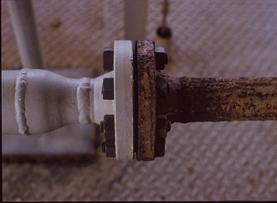 Also called two-metal corrosion, this occurs when two different metal or alloys are placed in contact with one another and are immersed in a corrosive or simply a conductive solution like sea water. When these distinct metals touch each other in this type of environment, it causes electron flow between them, which results in galvanic corrosion – with the less noble material being severely attacked and the more noble material suffering less attack.
Also called two-metal corrosion, this occurs when two different metal or alloys are placed in contact with one another and are immersed in a corrosive or simply a conductive solution like sea water. When these distinct metals touch each other in this type of environment, it causes electron flow between them, which results in galvanic corrosion – with the less noble material being severely attacked and the more noble material suffering less attack.
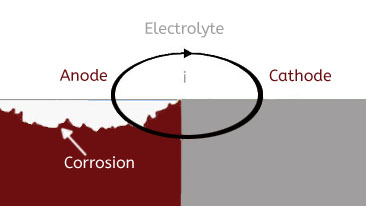 With regards to fasteners, it’s extremely important that the more noble material be the actual fastener, as galvanic corrosion could rapidly corrode the threads of a screw. The effects of galvanic corrosion could be minimized if the less noble material be significantly larger in mass. Like a screw going into a large piece of process equipment. The galvanic effects are distributed across a large mass and not concentrated on the relatively small threads. Galvanic corrosion could also be avoided by electrically isolating the fasteners with non-conductive polymers or ceramics.
With regards to fasteners, it’s extremely important that the more noble material be the actual fastener, as galvanic corrosion could rapidly corrode the threads of a screw. The effects of galvanic corrosion could be minimized if the less noble material be significantly larger in mass. Like a screw going into a large piece of process equipment. The galvanic effects are distributed across a large mass and not concentrated on the relatively small threads. Galvanic corrosion could also be avoided by electrically isolating the fasteners with non-conductive polymers or ceramics. 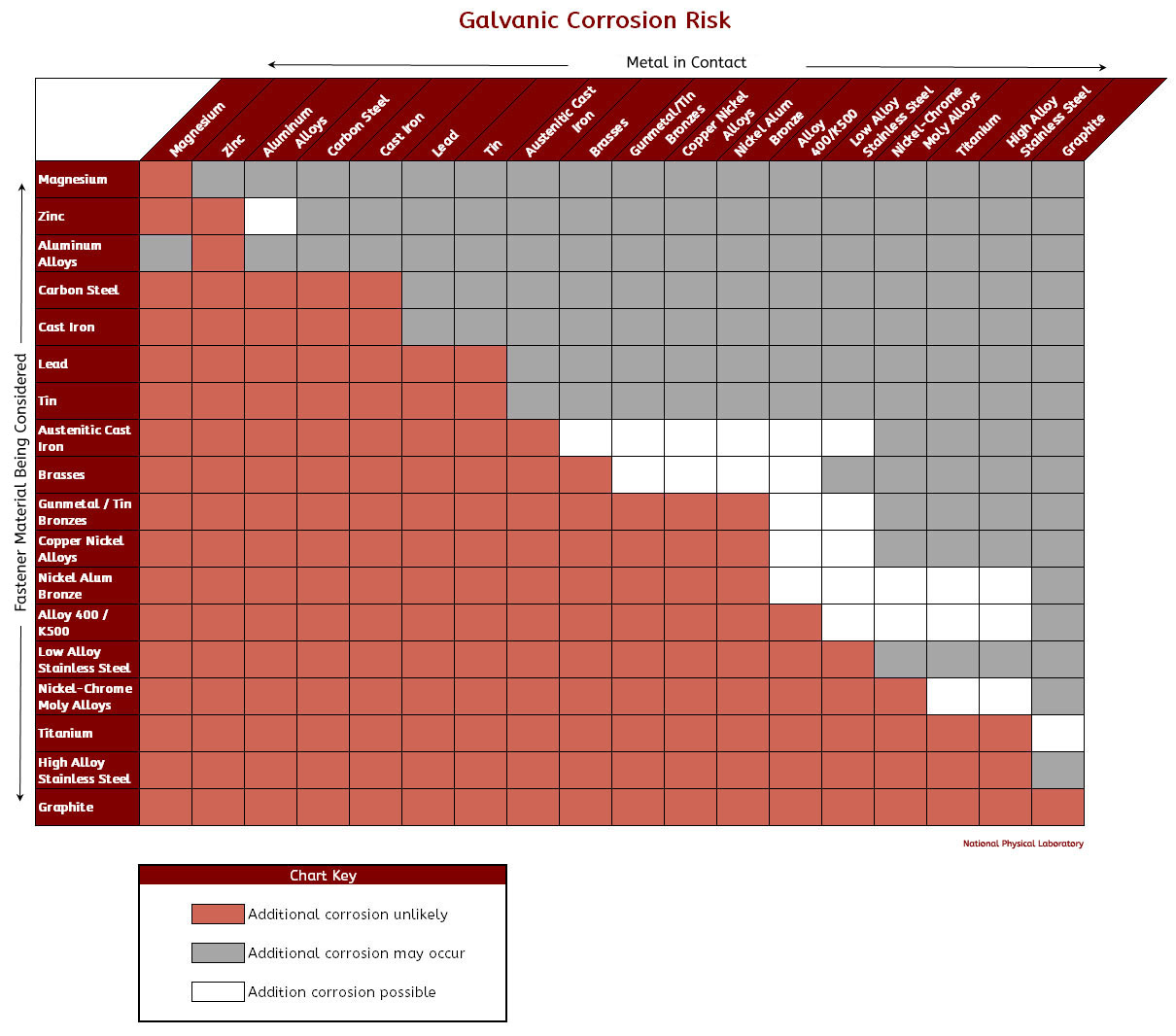

 The industrial segment has a broad range of requirements and we pride ourselves on being able to solve some of industries most challenging fastener applications. Working with our customers in the chemical processing, oil & gas, pharma, mining, electronics, alternative energy etc. we help them choose the best materials and fastener form for their tough applications.
The industrial segment has a broad range of requirements and we pride ourselves on being able to solve some of industries most challenging fastener applications. Working with our customers in the chemical processing, oil & gas, pharma, mining, electronics, alternative energy etc. we help them choose the best materials and fastener form for their tough applications. 